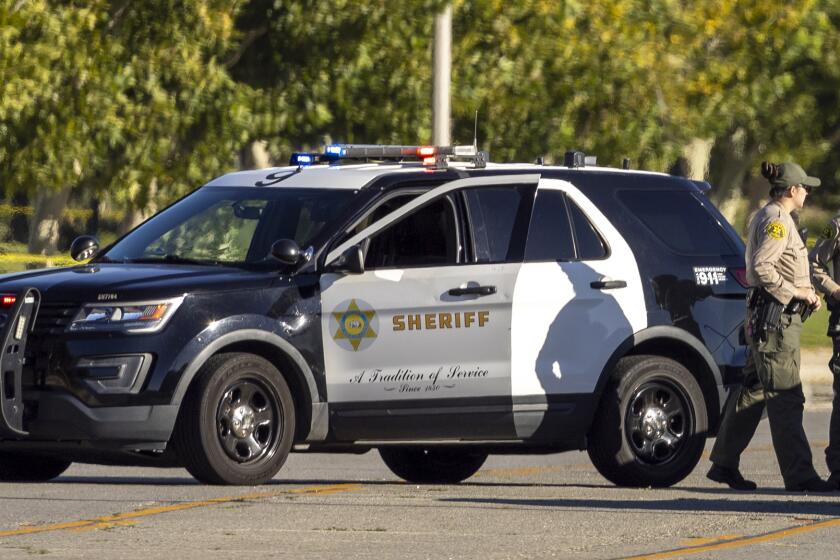Journey to Carmel Will Take Pontiff to the ‘Cradle of California’s Faith’
- Share via
CARMEL — Only an obscure cement slab in the floor at the Mission San Carlos Borromeo here indicates his grave: “Fray Junipero Serra, Apostol de California, 1713-1784.”
Yet, 1.5 million tourists and pilgrims a year crowd this small church and dwellings-turned-museum, which together are more commonly known as the Carmel Mission, to admire the place from where Serra and a handful of other Franciscan missionaries spread the gospel to the California natives. Whispering in foreign languages, small groups of visitors can be found standing in awe of the colorful reredos behind the church’s altar, just a few feet away from Serra’s grave.
Here, Pope John Paul II today will commemorate Serra’s missionary legacy with a private church ceremony. At the same time, some Indian groups will be protesting what they consider the missionary’s record of cruelty to their people. The Vatican has put off Serra’s expected official beatification, the second step in a time-consuming process toward sainthood.
Serra, who was born on the isle of Majorca and ordained a Franciscan priest about 1738, volunteered as a missionary to the New World in 1749 and was sent to Mexico. In 1769, he was entrusted by the church to preside over a mission chain to be established in Alta California.
He arrived at the shores of Monterey Bay on June 3, 1770, with the expedition of Don Gaspar de Portola, who was exploring and occupying New World territories on behalf of the Spanish king. Here, Serra initially planned the headquarters of his mission chain.
Strategically Important to Spanish
“The Monterey Peninsula was strategically very important to the Spanish,” said Father Tom Davis, mission historian at the San Fernando Mission. “Ships returning from the Philippines needed a safe haven from pirates on their way to Acapulco and the Russians wanted to establish themselves along the American West Coast. The church and the monarchy worked hand in hand in those days.”
A year later, poor soil and harsh treatment of native converts by Spanish soldiers from the neighboring presidio forced Serra to move the mission to a hill overlooking the Carmel River, its present site. He called it “Mission San Carlos Borromeo del Rio Carmelo,” after the patron saint of the then Spanish King Charles III. It remained his chief station and favorite mission until the day he died.
Moving into a hut on the new site, Serra directed the building of several wooden houses, a stockade and cattle corrals. Forty converted Indians from Baja California missions, three soldiers and five sailors were enlisted in the mission’s construction. At first, a large wooden cross acted as a place of daily worship until a small chapel was completed. A reconstruction of the cross still adorns the mission’s courtyard.
For the next 13 years, Serra and his fellow Franciscans journeyed on foot to tribal villages in the area, where they attracted the natives by hanging a large bell from a tree and ringing it loudly. It was his goal to convert the Indians to Christianity and settle them in mission communities, where they would be fed, clothed and housed. More than 4,000 Indians were baptized at Carmel between 1770 and 1836 and 3,000 are buried in and around the mission.
Pinnacle of Prosperity in 1790s
From the Mission San Carlos, the friars established seven new missions between San Diego and San Francisco. When Serra died on Aug. 28, 1784, Father Fermin Francisco de Lasuen became “padre president” of the mission chain and started the construction of the Moorish-style church at Carmel in 1793. Indigenous sandstone was quarried from the nearby Santa Lucia Mountains and the church was completed four years later.
Prosperity at the mission reached its pinnacle in the mid-1790s when the Indian population reached 927 and agricultural crops were abundant. But by 1823 only 381 Indians were left there and the mission was secularized in 1834.
“That was done under pressure from the Mexican government as a way to get the church’s land,” Davis said, claiming that the padres had always held the Indians’ land in the church’s trust. “The (Abraham) Lincoln government returned the land to the church in 1863.”
Restoration Begun in 1884
But the Mission San Carlos was already in ruins by then and it was not until 1884, when Father Angelo Casanova of the Monterey Parish took control of the church, that its restoration was begun. It was completed after 1931, when the Diocese of Monterey appointed the late Harry Downie, the mission’s first and exceptionally devoted curator.
In 1960, Pope John XXIII raised the Carmel Mission to the status of minor basilica for its importance as a historical shrine and the “cradle of California’s faith,” as Bishop Aloysius Willinger of this diocese put it in his petition to the Vatican. It remains one of the country’s 12 minor basilicas to this day.
Mission San Carlos, which is an active congregation of 1,000 families, now houses a primary school, a small convent, the residence of Bishop Thaddeus A. Shubsda of the Diocese of Monterey, a gift shop and a museum devoted to the history of the mission.
More to Read
Sign up for Essential California
The most important California stories and recommendations in your inbox every morning.
You may occasionally receive promotional content from the Los Angeles Times.













